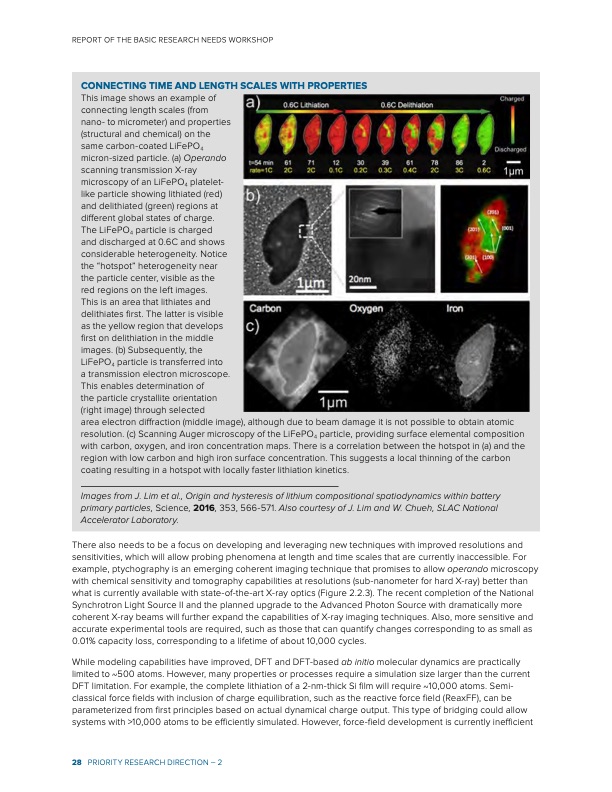
PDF Publication Title:
Text from PDF Page: 034
REPORT OF THE BASIC RESEARCH NEEDS WORKSHOP CONNECTING TIME AND LENGTH SCALES WITH PROPERTIES This image shows an example of connecting length scales (from nano- to micrometer) and properties (structural and chemical) on the same carbon-coated LiFePO4 micron-sized particle. (a) Operando scanning transmission X-ray microscopy of an LiFePO4 platelet- like particle showing lithiated (red) and delithiated (green) regions at different global states of charge. The LiFePO4 particle is charged and discharged at 0.6C and shows considerable heterogeneity. Notice the “hotspot” heterogeneity near the particle center, visible as the red regions on the left images. This is an area that lithiates and delithiates first. The latter is visible as the yellow region that develops first on delithiation in the middle images. (b) Subsequently, the LiFePO4 particle is transferred into a transmission electron microscope. This enables determination of the particle crystallite orientation (right image) through selected area electron diffraction (middle image), although due to beam damage it is not possible to obtain atomic resolution. (c) Scanning Auger microscopy of the LiFePO4 particle, providing surface elemental composition with carbon, oxygen, and iron concentration maps. There is a correlation between the hotspot in (a) and the region with low carbon and high iron surface concentration. This suggests a local thinning of the carbon coating resulting in a hotspot with locally faster lithiation kinetics. Images from J. Lim et al., Origin and hysteresis of lithium compositional spatiodynamics within battery primary particles, Science, 2016, 353, 566-571. Also courtesy of J. Lim and W. Chueh, SLAC National Accelerator Laboratory. There also needs to be a focus on developing and leveraging new techniques with improved resolutions and sensitivities, which will allow probing phenomena at length and time scales that are currently inaccessible. For example, ptychography is an emerging coherent imaging technique that promises to allow operando microscopy with chemical sensitivity and tomography capabilities at resolutions (sub-nanometer for hard X-ray) better than what is currently available with state-of-the-art X-ray optics (Figure 2.2.3). The recent completion of the National Synchrotron Light Source II and the planned upgrade to the Advanced Photon Source with dramatically more coherent X-ray beams will further expand the capabilities of X-ray imaging techniques. Also, more sensitive and accurate experimental tools are required, such as those that can quantify changes corresponding to as small as 0.01% capacity loss, corresponding to a lifetime of about 10,000 cycles. While modeling capabilities have improved, DFT and DFT-based ab initio molecular dynamics are practically limited to ~500 atoms. However, many properties or processes require a simulation size larger than the current DFT limitation. For example, the complete lithiation of a 2-nm-thick Si film will require ~10,000 atoms. Semi- classical force fields with inclusion of charge equilibration, such as the reactive force field (ReaxFF), can be parameterized from first principles based on actual dynamical charge output. This type of bridging could allow systems with >10,000 atoms to be efficiently simulated. However, force-field development is currently inefficient 28 PRIORITY RESEARCH DIRECTION – 2PDF Image | Next Generation Electrical Energy Storage

PDF Search Title:
Next Generation Electrical Energy StorageOriginal File Name Searched:
BRN-NGEES_rpt-low-res.pdfDIY PDF Search: Google It | Yahoo | Bing
Sulfur Deposition on Carbon Nanofibers using Supercritical CO2 Sulfur Deposition on Carbon Nanofibers using Supercritical CO2. Gamma sulfur also known as mother of pearl sulfur and nacreous sulfur... More Info
CO2 Organic Rankine Cycle Experimenter Platform The supercritical CO2 phase change system is both a heat pump and organic rankine cycle which can be used for those purposes and as a supercritical extractor for advanced subcritical and supercritical extraction technology. Uses include producing nanoparticles, precious metal CO2 extraction, lithium battery recycling, and other applications... More Info
| CONTACT TEL: 608-238-6001 Email: greg@infinityturbine.com | RSS | AMP |